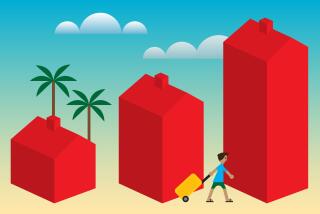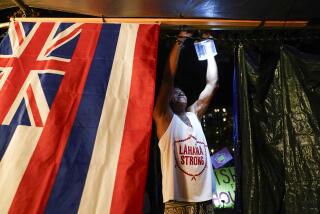TRAVELING in style : Paring the Price of Paradise : How savvy travelers to the Aloha State can trim their tabs and never miss out on the good life: Cost-cutting tips for everything from lodgings to luaus, shopping to sightseeing.
- Share via
It had been a busy day of sun and surf, and I was recharging with a free welcome cocktail on my hotel terrace in a tiny beachfront garden, a seashell’s throw from the Hilton Hawaiian Village.
As I idly glanced up at the resort’s skyscrapers, I caught a Hilton guest looking down on me--socially as well as logistically, it was clear. His eyes quickly dismissed the rustic two-story complex comprising my lodging, its lone “tower” a puny six stories.
But my little patch of paradise--called the Waikikian on the Beach--had its charms. It was friendly and attractive, with Polynesian-style thatched-roof units bordering a torch-lit garden path. Though my lofty neighbor may not have been lured by my one small restaurant-nightspot, I liked its folksy appeal. On the other hand, I also regularly tapped the adjoining Hilton’s handy wealth of shops, eateries and entertainment. And, of course, we both shared the same stretch of wide and wonderful Waikiki Beach. The Waikikian’s biggest plus, however, was my daily tab: $59.
OK, so I didn’t have a TV set or air-conditioning. But who needs “Roseanne” when you have ukuleles and hula dancers at your doorstep? And Hawaii’s brisk trade winds cooled my basic-level room so effectively that I never switched on the ceiling fan.
The Waikikian is only one of a number of lesser-known alternatives to the major hotels that house most Honolulu tourists. Some of the biggies are budget-minded, too, but visitors who stake out one of the smaller, homier oases are more likely to be beguiled by a certain Hawaii magic.
Another low-rise charmer even closer to the center of the action is the 95-room Hawaiiana, set in a lushly landscaped private enclave half a block from the beach. Its two- and three-level units--some with terraces, or lanais, as they are called in the Aloha State--snake around two swimming pools. A spacious double here, with color TV, air-conditioning and fully equipped kitchen, runs $75 to $95. The cordial Hawaiiana offers a wealth of free extras, including beach mats, morning coffee and juice, daily newspaper delivered to your door, use of a washer and dryer, plus a welcoming gift of a fresh pineapple and a parting remembrance of a fragrant flower lei. You’ll find a lot of regulars, and you’ll feel as if you’re among old friends from the minute you check in.
For a refuge altogether removed from the tourist fray, there’s the venerable Manoa Valley Inn, tucked away on a residential street two miles from the beach, near the University of Hawaii campus. You’ll feel like a wealthy landowner while relaxing on the wide veranda of this lovingly restored plantation house, which was snatched from demolition by Rick Ralston, president of trendy Crazy Shirts, and is now on the National Register of Historic Places.
Rates for the seven antique-furnished rooms and private cottage are $80 to $145 and include a generous continental breakfast plus afternoon wine and cheese. Guests are encouraged to help themselves to decanters of sherry and bowls of candies on the second- and third-floor landings, and are urged to play the old-fashioned nickelodeon (a pile of nickels is provided) or the new-fangled TV and VCR in the parlor. You may hardly see another guest and half-believe the house is yours alone, or you may strike up friendships as you watch the lights of Waikiki twinkle on at dusk from the porch swing of this hillside perch. Visitors without a rental car can catch the No. 4 bus two blocks away and be on the beach in 15 minutes.
The Manoa Valley Inn is the showplace among the growing number of B&B;’s in the Hawaiian islands. Numerous agencies--some local, some statewide--match guests and rooms, the cost of which start as low as $20 a night plus a small reservation fee. You may even luck into a view of your own and a private beach. Most B&Bs;, though, are a considerable distance from the bright lights of Waikiki, so a car is advisable.
We found other inexpensive Waikiki lodgings. The Outrigger chain offers a score of possibilities, most in the budget range. And the Hawaii Visitors Bureau publishes a free tip sheet, Hawaii on a Budget, listing hotels, condos, cottages and B&B;’s for each island, under the heading “Where to Stay for Under $65 per Day.”
If you stay at one of the several dozen hotels affiliated with a new local agency, the Hotel Exchange, which has set up shop in the Hawaiian Colony Hotel at 1946 Ala Moana Blvd., near the Hilton, you can save $10 to $25 on the daily room rate. I stumbled upon the agency through an ad in a Waikiki tourist magazine and shaved $10 off the already bargain price of $69 that was quoted to me by the Waikikian. Now the Exchange expects to sign up several major hotels in Waikiki, so that those who insist on traveling in style can save a few bucks, too.
Following is a guide to keeping down costs in other categories.
Air-hotel packages usually are the cheapest option for tourists who don’t mind an if-it’s-Tuesday-this-must-be-Oahu pace. Independent travelers do best if they can snag one of the air fare specials that crop up now and then--particularly in spring and fall.
Island-hopping is the local pastime so inter-island fares are fairly reasonable ($49.95 one way between Honolulu and any other island). You can save $15 each way by taking the first and last flight of the day.
Getting around: To get from Honolulu airport to Waikiki, hop a shuttle bus outside the terminal. The tab is $5 to any hotel, as opposed to $15 or $20 for a cab.
I’d skip the Waikiki Trolley, which for $10 offers a cursory spiel and an all-day pass allowing passengers to jump on and off at pickup points around town. You’ll do as well for less on the public buses, guidebook in hand; the fare is 60 cents--whether you ride down the block or around the island.
Rental cars are advertised at rates as low as $5 a day, although you’ll probably spend closer to $20, since the rock-bottom models never seem to be available. Shop around. Most car-rental firms also offer tie-in discounts at various tourist attractions.
Many hotels and restaurants advertise happy hours--some run virtually all day--featuring snacks, music and reduced drink prices (as low as $1.50 for the ubiquitous Mai Tai or Tropical Itch, the latter served with a 12-inch back scratcher as a swizzle stick).
Shopping: Waikiki wares run the gamut from trash to treasure, and it is possible to find lovely fashions among the millions of mass-produced muumuus and aloha shirts. Before you buy anything anywhere, compare prices at the ABC convenience stores and at Liberty House, the Macy’s of Hawaii.
If you really love a bargain, take the escalator to the fifth floor of the Waikiki Shopping Center on main-drag Kalakaua Boulevard and browse through Betty’s Import and Export, where for 50 cents or $1 you can find the same shell-and-stone jewelry you see in the International Bazaar shops for 10 or 20 times more. Stop at the third floor, as well, and look in on Ali’s Jewelry and Exotic leather, where prices of soft eel-skin items such as wallets start at $5.
Less widely known than the popular Kodak Hula Show in Kapiolani Park, near Diamond Head volcano, is the Young People’s Hula Show at 9:30 a.m. every Sunday at the opposite end of Waikiki, on Center Stage in Ala Moana mall. The pint-sized dancers--boys as well as girls, some as young as 2--show off what they’ve learned about Hawaii’s cultural traditions, and their contortions will tickle you more than running into Richard Chamberlain and the cast of “Island Son.” It’s one show that would be worth almost any price, but it underscores the fact that even in Hawaii, many of the most enjoyable things are free.
More to Read
Sign up for The Wild
We’ll help you find the best places to hike, bike and run, as well as the perfect silent spots for meditation and yoga.
You may occasionally receive promotional content from the Los Angeles Times.






